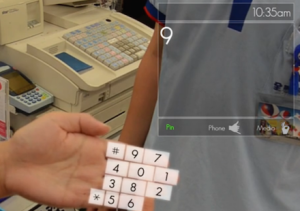Possibly the most innovative announcment at the 2014 Wearable Tech Expo in New York this week was the augmented reality (AR) infrastructure just debuted by the Finnish company Augumenta. The platform is operating system agnostic, sitting between the hardware and whatever software is running and lending that software a “natural, touch-free interaction”. Specifically, the system recognizes the input that the application is looking for and then uses augmented reality to create a user interface (UI) that is operated by Augumenta’s robust gesture recognition. Integration of the Augumenta system would add manual control to AR systems that would otherwise be limited to voice commands or physical controls (buttons, swipes, blinks, etc).
 The demonstration of the Augumenta system showcased the accuracy of the gesture recognition system with a version of rock-paper-scissors played versus an artificial opponent and including additional gestures that were very similar to the standard three. The presentation did a fairly accurate job of differentiating between the similar gestures and seemed to be only slowed down by the physical connection necessary for demonstrating within the concrete bunker-like space in the lower level of the Javits Convention Center.
The demonstration of the Augumenta system showcased the accuracy of the gesture recognition system with a version of rock-paper-scissors played versus an artificial opponent and including additional gestures that were very similar to the standard three. The presentation did a fairly accurate job of differentiating between the similar gestures and seemed to be only slowed down by the physical connection necessary for demonstrating within the concrete bunker-like space in the lower level of the Javits Convention Center.
Far more innovative was Augumenta’s utilization of their gesture recognition: the demonstration continued with an application that was waiting for the input of a PIN code, the user simply looked at their own palm and waited a moment for an augmented reality numeric keypad to appear there. The obvious benefit of this is that there is no chance of someone observing a user entering their PIN if the keypad is invisible to everyone except the intended user. More examples of how Augumenta’s combination of AR and gesture recognition are shown in the company’s most recent video, including an augmented reality viewfinder for head-mounted cameras.
Augumenta Interaction Platform from Augumenta on Vimeo.
There is incredible potential for the tools that Augumenta will provide to developers — the biggest question is one of adoption as consumer-level smart glasses enter the market. The gesture recognition half of the platform is currently in private beta with a handful of manufacturers and is expected to be openly available to developers by the end of the year. We were told that the augmented reality component is expected to be released by early 2015 and should work on Google Glass as well as smartglasses from ChipSiP and Epson.
Someone is going to fill the need for controlling the deluge of wearable devices that will be coming in the near future… Augumenta is certainly showing a grasp of the ideas that is far ahead of it’s time.
